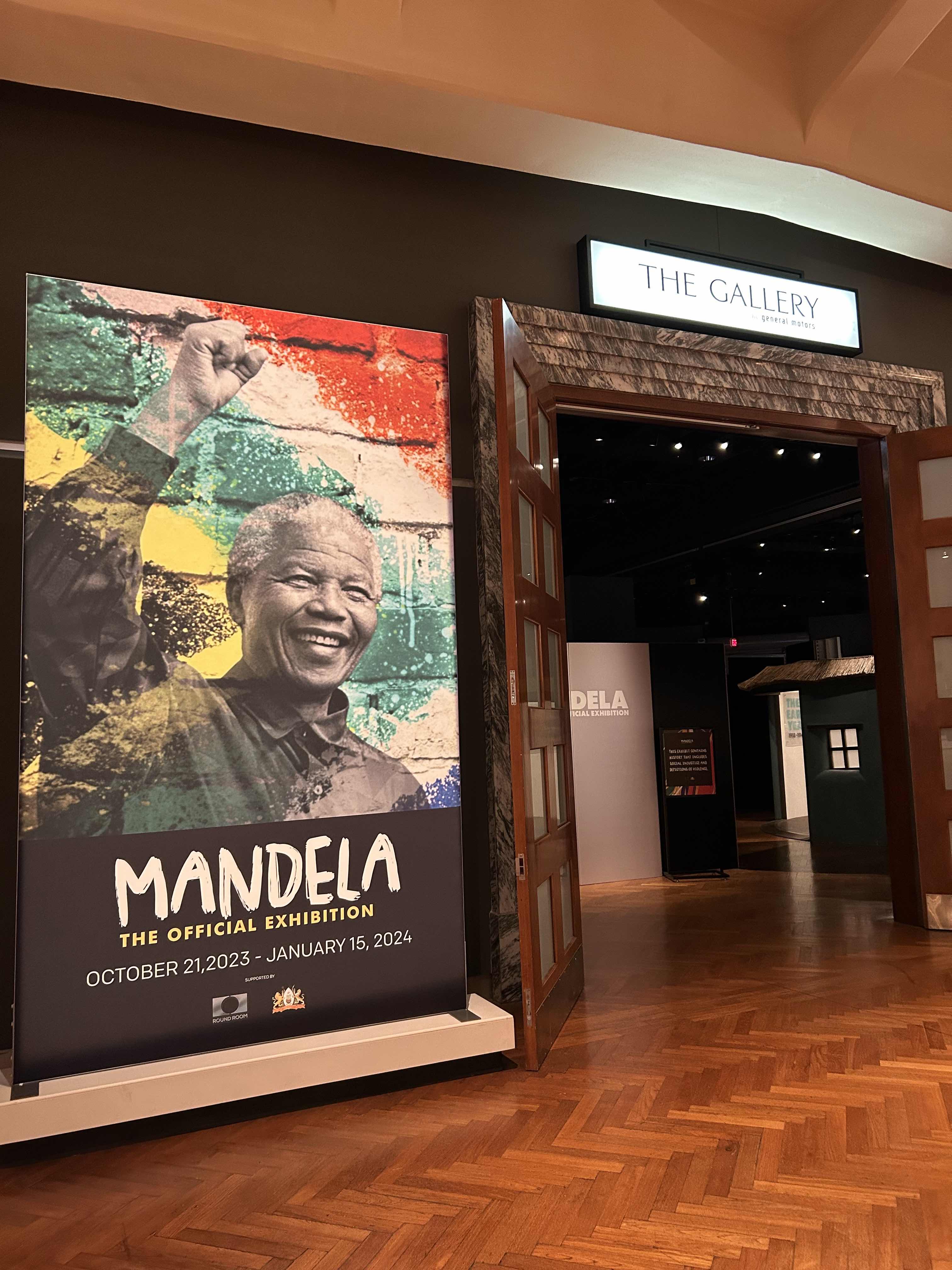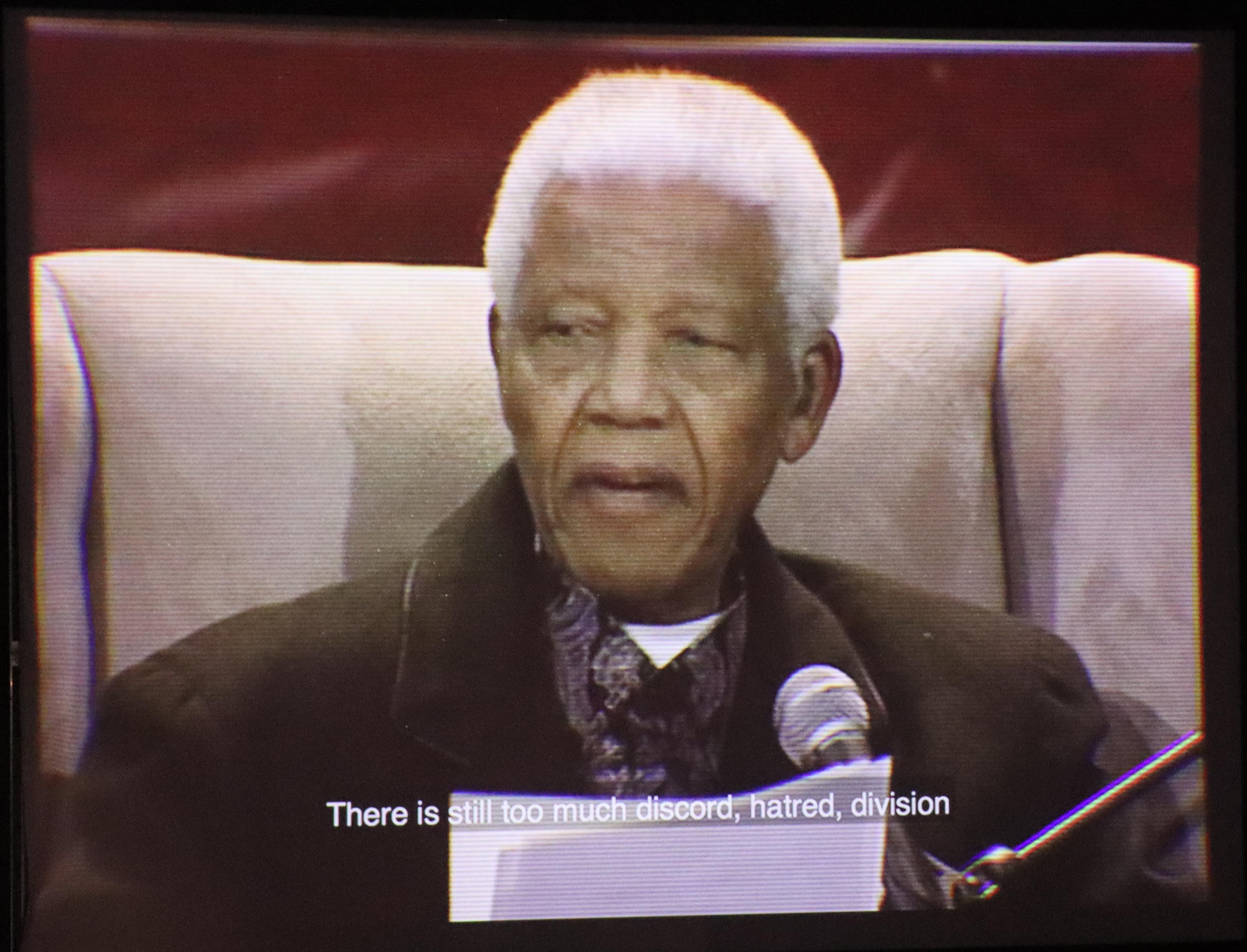“Mandela: The Official Exhibition” Featured at The Henry Ford Museum in Dearborn

Entrance to "Mandela: The Official Exhibition" at The Henry Ford Museum. Photo by Ashley Davis
The Henry Ford Museum of American Innovation is hosting an immersive exhibition inspired by the life and legacy of Nelson Mandela. The exhibit is an emotional recounting of Mandela’s journey to becoming one of the greatest freedom fighters and political leaders to ever live, and shows how his contributions continue to influence the modern world.
Kate Morland is the head of exhibitions and performances at The Henry Ford Museum. She provides some general insight on Mandela’s historical significance. “Nelson Mandela was the first president of South Africa elected under a non-racial constitution. South Africa has a long history of apartheid, which is a systematic and legal method of segregation that was enforced throughout the country in the 20th century. Mandela fought against that and was imprisoned for 27 years. [When he was] freed he became the president, working with the segregated government to move into a new form of democracy.”
“Mandela: The Official Exhibition” is unique as it features more than 150 artifacts and personal belongings, some of which have been loaned directly from the Mandela family. The interactive experience begins with his childhood upbringing, then transitions to his career as a lawyer and activist. The remaining galleries are dedicated to examining his time spent in prison, the aftermath of his release, and the global impact of his lifetime fight for justice.
The Nobel Peace Prize awarded to Nelson Mandela in 1993 on display at "Mandela: "The Official Exhibition" at The Henry Ford Museum of American Innovation, Dearborn, MI. Photo by Ashley Davis
Morland adds more context. “It starts from when [Mandela] was a child, so you can see how someone’s childhood may have influenced who they became later in life. After that, it introduces the struggle, which is the civil rights struggle against apartheid. It does a good job charting his life and interweaving that with an accessible amount of South African history.”
Exhibit at "Mandela: The Official Exhibition" at The Henry Ford Museum of American Innovation, Dearborn, MI. Photo by Ashley Davis
She continues to discuss what sets this display apart from exhibitions that may have been dedicated to Mandela in the past. “We have objects here that Mandela actually used, [like] his cup and bowl set from while he was in prison. We have objects he used when he was a child. One of the strengths of museums is having an experience where you are in the presence of something from the past, and that might [establish] a personal connection.”
Mandela’s lengthy prison sentence in response to his fight against the horrors of apartheid is undoubtedly an important part of his story. His perseverance during his imprisonment inspired people all over the world to plead for his release. Perhaps this is why Morland says that section of the gallery has garnered the most attention. “I think visitors tend to be drawn to the prison section of the exhibit because it very clearly shows what life was like in South Africa for a political prisoner. [There is] an artistic recreation of the size of his cell at Robben Island, so you can feel what it may have been like to be in that sort of space.”

Recreation of cell where Nelson Mandela was imprisoned for 27 years, "Mandela: The Official Exhibition" at The Henry Ford Museum of American Innovation, Dearborn, MI. Photo by Ashley Davis
The museum aims to be a catalyst to encourage visitors to become agents of change in their own communities through advocacy and collaboration.
Morland says, “It is always our hope with exhibits that people are inspired to create a better future. Mandela was able to gather people around himself and leverage their talents, he was a consensus builder. I think the exhibit shows that he was able to consolidate that support from a variety of ethnic groups in South Africa [into] compromise and consensus in order to move into this better future. People can really take away the concept of building a team of people who might not agree about everything [but are willing to work] toward a shared goal.”

Exhibit at "Mandela: The Official Exhibition" at The Henry Ford Museum of American Innovation, Dearborn, MI. Photo by Ashley Davis
Morland goes on to talk about how continuing to document Mandela’s legacy can provide insight when it comes to contemporary world problems. “It’s important because we still see freedom struggles going on today. In our world, not everyone is free, legally, [or] in a de facto way. I also think it’s important for Americans to understand world history, and how they’re part of a greater world history.”
The exhibition isn’t Mandela’s first connection to the Detroit area. Mandela visisted the Motor City months after his February release on June 28th, 1990. His goal was to garner support and put pressure on the segregated government in South Africa to transition into a democracy.
Time Magazine cover, June 28, 1990, on display at "Mandela: The Official Exhibition" at The Henry Ford Museum of American Innovation, Dearborn, MI. Photo by Ashley Davis
Morland explains some details about his visit to Detroit. “He went to Tiger Stadium and spoke to an enormous crowd there. He spoke with the UAW and listened to Motown music. So he really had a love for Detroit, and it’s nice to have that historical connection.“
The Henry Ford Museum of American Innovation plans to continue placing an emphasis on the people, places and events that have significantly impacted history.
“Freedom movements are part of social history, which is a focus of [ours.] Our ‘Liberty and Justice for All’ exhibit talks about a variety of American freedom movements that we hope to educate the public on. This [exhibition] is South African, and some might think that because it’s a different country it’s outside of our scope of focus, but we’re all interconnected,” Morland said.
“Mandela: The Official Exhibition” will be at the Henry Ford Museum of American Innovation in Dearborn until January 15. Tickets can be purchased on their website, thehenryford.org, or at the door. The museum is open 9:00 a.m. to 5:00 p.m., Monday - Friday, 9:00 a.m. to 3:00 p.m. Saturday, and 9:00 a.m. to 1:00 p.m. Sunday.

